Background to the Kentucky Militia Volunteers at new Orleans.
Contrary to popular myth the Kentucky volunteers who volunteered to fight at New Orleans were not all equipped with the 'long rifle.' The minority (approximately a third) who were armed had muskets. As the result of a request of Major-General Jackson to the Kentucky Governor, a large contingent of poorly equipped and uniformed volunteers left Louisville on 21st November, 1814 under the command of militia Major-General John Thomas and his second Brigadier-General Adair. As they approached New Orleans Thomas became ill and Adair took command. Poorly provisioned this rag tag group floated down the Cumberland and Mississippi rivers in overcrowded flat bottomed boats with twenty-five of them dying along the way.
The Kentuckians arrived in a gaggle spread over several days from the 2nd to 4th January, 1815 now led by Adair. Adair is described as looking like Reuben Kemper (a frontier backs woodman in the ilk of Daniel Boone and Davey crocket) "with his simple dress and rough and tumble look." Jackson appealed to Governor Claiborne to provide arm for the Kentuckians. Claiborne managed to secure 250 to 300 guns from the "Corps of Exempts" and the rest of the guns were a 'multiplicity of every description, caliber and antiquity' from local citizens.
Kentucky Volunteer Militia Uniforms.
This plate illustrates the Kentucky volunteers that participated in Harrison's 1813 campaigns leading to the The Battle of the Thames (Moravian town). Some of the New Orleans Kentucky volunteers would be dressed as above but most were not.
These Kentucky militiamen are equipped with rifles and the semi-official uniform of red trimmed frock coat in various shades of black and some faded as on the right.
This depiction of Kentucky Volunteers at the battle of River Raisin in January 1813 is getting closer to the rag tag appearance they wore at New Orleans.
This is the most realistic portrayal of the rag tag appearance of the Kentucky militia at New Orleans. The caption in the excellent Osprey booklet is worth quoting in its entirety.
"Many had no weapons, were shoeless, and dressed in rags. The citizens of New Orleans collected old clothing and fabric to clothe them against the bitter cold. The wealthier officer at far right wears the less expensive officer's uniform allowed by special regulations, a blue hunting shirt and trousers trimmed in red. His only rank badge is a red waist sash. The ragged infantryman at left wears 'frontier boots' simple moccasins and leggings of old cloth tied on with strings. The private at center wears a cloth skirt, coat cut from an old blanket, and is armed only with a knife and cudgel. These militia formations were armed with an assortment of scavenged firearms, and even farm implements collected from around New Orleans. Jackson used the Kentucky militia primarily as a reserve."
Clearly the the New Orleans Volunteers were not in the same class as the their brethren who fought under Shelby and Johnson on the Northwest Frontier. By way of a British football analogy, they were definitely fourth division gents.
My depiction of the Kentucky Militia Volunteers at the Battle of New Orleans.
The figures are mostly Boot Hill, some North Star and a few Knuckleduster. This is the 13th Kentucky Militia Regiment commanded by Colonel Slaughter.
A close up of the 13th. The Kentucky stated flag is specially commissioned by Maverick Models. It is a bit too big but it will do. These Boot Hill figures are full of character and with a few rips and patches give a rag tag appearance. Note the variety of weapons from muskets to rifles and even shotguns.
The 14th Kentucky Volunteer Regiment with LtCol S. Parker commanding. Note the gents in the cloth coats. Most are wearing their civilian frontier garb with some wearing the traditional hunting shirt coat trimmed in red.
A close up of the the 14th Kentucky Volunteers
References:
The Greatest Fury, by William C. Davis (IMHO the best and most detailed account of the battle)
Frontier Militiaman In The war of 1812: Southwestern Frontier, Osprey Warrior # 129.
Armies of the War of 1812, by Gabriel Esposito.
Years of Growth, 1796-1851: Military Uniforms in America, The Company of Military Historians.
Next: Louisiana militia artillery and Baratarian pirate gunners.
---------------------------------------------------------------------------------
Unrelated to the subject is my recently completed depiction of a LCol. battalion commander of the 79th Cameron Highlanders. I am not a good tartan painter but I am pleased with this result using a combination of paint and micro pens. This mounted Front Rank figure along with the rebasing of figures, completes the battalion of highlanders figures that were painted by Mike. I am honored to have them.











No comments:
Post a Comment